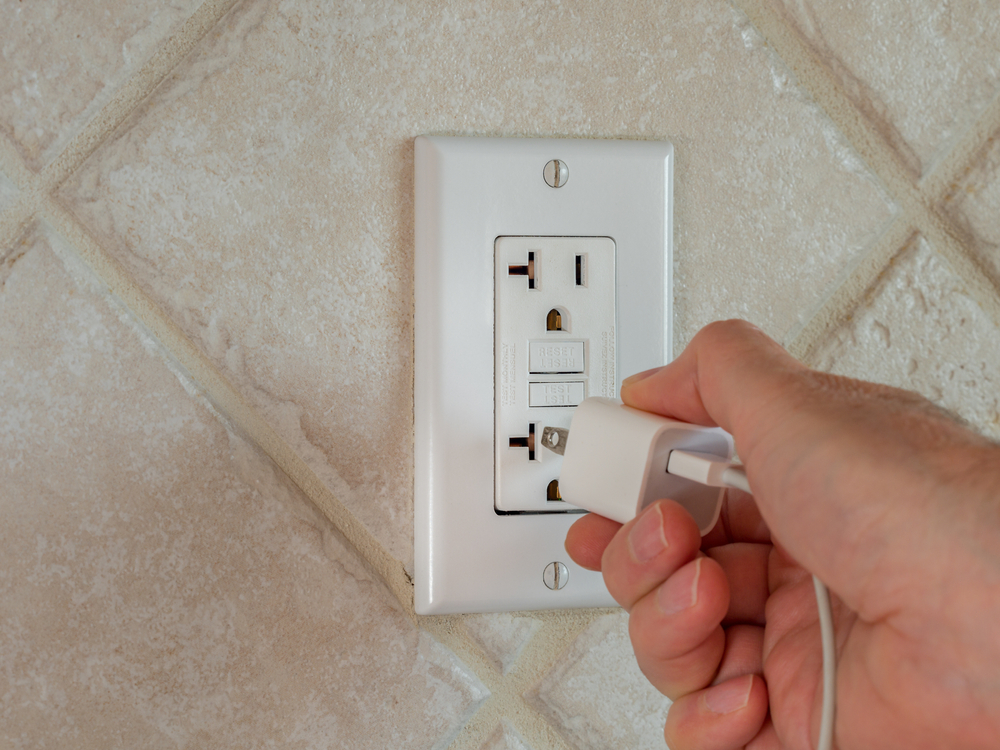Did you just try to plug in your phone charger, expecting that familiar “bloop” sound signaling a connection, only to hear nothing? Maybe you wiggled the cord, tried another device, or even plugged the charger into a different outlet, only to realize that the charger wasn’t the problem — the original outlet was.
This common problem often sparks the questions, “Why do electrical outlets sometimes stop working?” and “Is there anything you can do to restore power to that wall socket?”
Let’s go through the potential reasons your electrical outlet may have stopped working so you can better understand what’s going on behind your home’s walls.
You Have a Tripped Circuit Breaker
One of the most common reasons an electrical outlet isn’t working is a tripped breaker. Your electrical panel is designed to protect your home from power surges, overloads, and short circuits by cutting off power when necessary. If a breaker trips, it shuts off power to the affected circuit, which can make it seem like an outlet (or an entire room) has suddenly gone dead.
Head to your electrical panel and look for a switch that’s in the “off” position or somewhere in between “on” and “off.” If you find one, flip it all the way off and then back on. If power is restored, the issue is likely an overloaded circuit. However, if the breaker keeps tripping, you may need to call an electrician for residential electrical repairs to resolve the deeper issue.
A GFCI Outlet Has Tripped
Ground fault circuit interrupter (GFCI) outlets are safety devices found in areas where water is present, such as kitchens, bathrooms, garages, and outdoor spaces. If a GFCI outlet detects an electrical imbalance — like water interfering with the circuit — it automatically shuts off power to protect you from electric shocks.
If your electrical outlet is not working and it’s near a sink or another water source, check to see if it’s a GFCI outlet. You’ll notice two buttons labeled “Test” and “Reset.” Press the reset button and see if the outlet starts working again. If it doesn’t, the GFCI might be faulty, or there could be an issue elsewhere in your wiring that requires professional attention.
The Outlet Is Part of a Switched Circuit (or Is a Half-Hot Outlet)
Some outlets in homes are connected to a wall switch and are considered half-hot outlets. If your electrical outlet isn’t working, check if there’s a switch nearby that might control it. These switched outlets are commonly used for lamps or other devices meant to be controlled without needing to reach down to the plug. Try flipping these switches and see if the outlet regains power. If not, you may need to investigate further to determine if there’s an issue with the switch, wiring, or circuit.
A Wire Has Come Loose or Disconnected
Sometimes, an electrical outlet stops working due to loose wires. Over time, the wiring connections may lose strength due to repeated use, age, or poor installation. If your outlet has lost its connection, it won’t provide power — even if nothing else seems wrong.
While it might be tempting to remove the cover plate and inspect the wires yourself, this is risky unless you have electrical expertise. Loose wiring can cause sparks, leading to fires or electrical shocks. It’s best to contact a professional who provides electrical outlet wiring services to ensure your home’s wiring is safe and secure.
The Outlet Has Burnt Out
A less common but still possible reason your electrical outlet is not working is that it has burnt out. This can happen if an outlet overheats due to excessive use, a power surge, or a faulty device plugged into it. Burnt outlets can have visible discoloration, a burning smell, or even small scorch marks around the socket.
If you notice any of these signs, do not attempt to use the outlet. Unplug anything connected to it immediately and call a professional electrician. A burnt outlet can pose a serious fire hazard and should be replaced as soon as possible to prevent further damage.
The Outlet Is Old
Like any other part of your home, electrical outlets don’t last forever. If your home is older and still has its original outlets, normal wear and tear could be the cause of your outlet’s failure. For example, the metal contacts inside the outlet may have degraded, making it difficult for a plug to establish a firm connection. This can lead to intermittent power issues or complete failure.
If your home is older and you’re dealing with multiple dead outlets, it may be time to consider a new outlet installation to bring your electrical system up to date.
When You Should Call an Electrician for Troubleshooting a Faulty Outlet
While some electrical troubleshooting steps, like checking your electrical panel or resetting a tripped GFCI outlet, are safe for homeowners to do, anything beyond that should be left to a licensed electrician. Working with electricity without proper training is dangerous and can lead to electrocution or fire hazards.
The professional electricians at Saffer Plumbing, Heating & Electrical have the experience and tools needed to identify why your electrical outlet is not working and fix it safely. We can also upgrade all of your home’s wiring if the issue extends beyond one single outlet.
Need Help With a Faulty Outlet? Contact Saffer Plumbing, Heating & Electrical
If your electrical outlet isn’t working and you’re not sure why, don’t take any risks — get in touch with the experts at Saffer Plumbing, Heating & Electrical. Our experienced electricians in Baltimore can diagnose the problem and provide the necessary repairs and replacements to keep your home’s electrical system running safely and efficiently.

